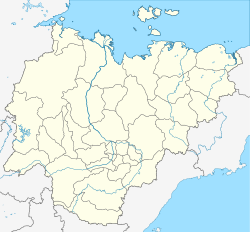Amga (place)
Selo
|
||||||||||||||||||||||||||||||
|
||||||||||||||||||||||||||||||
|
||||||||||||||||||||||||||||||
Amga ( Russian Амга́ ; Yakut Амма / Amma ) is a village in the Sakha Republic (Yakutia) with 6533 inhabitants (as of October 14, 2010).
geography
The settlement is situated in the northeastern part of the Lena plateau , about 175 line kilometers southeast of the capital of Republic of Yakutsk , on the left bank of the same name Aldan -Nebenflusses Amga , at the mouth of the Krestjach.
Amga is the administrative center of the Ulus (Rajons) Amga .
history
The village was founded by Russian Cossacks in 1652 while they were advancing east, making it one of the oldest Russian settlements in Eastern Siberia . It was initially named after the Amga-Sloboda or Sloboda Amga river ; the river name itself is of Evenk amnga for Canyon derived Sloboda is a common Russian name primarily for trade and craft settlements. In 1680 the first Russian Orthodox church was built, which burned down several times and was rebuilt. From 1695 agriculture was practiced in the area. This made the area Yakutia's first arable farming area.
Amga was a place of political exile in the 19th and early 20th centuries . Between 1879 and 1885 the Russian writer Vladimir Korolenko spent several years of his exile, from 1881 to 1886 the Narodowolze Ossip Aptekman and from 1901 to 1904 the writer Georgi Tschulkow .
During the Russian Civil War , Amga and the surrounding area were the scene of bitter fighting between red and white troops under Anatoly Pepelyayev .
Since 1911 Amga was the administrative seat of an ulus; In 1930 it became the center of the Rajons of the same name within today's boundaries (today again referred to as Ulus).
Population development
| year | Residents |
|---|---|
| 1939 | 1230 |
| 1959 | 2348 |
| 1970 | 3542 |
| 1979 | 4103 |
| 1989 | 5191 |
| 2002 | 6359 |
| 2010 | 6533 |
Note: census data
Culture and sights
Since 1965, Amga has had a museum mainly dedicated to the events of the Russian Civil War.
Economy and Infrastructure
Amga is the center of an agricultural area with cattle and horses as well as the cultivation of potatoes and vegetables. There are some processing companies for regional needs.
The place is the end point of the regional road R502, via the year-round connection to Nizhny Bestjach , on the M56 trunk road on the right bank of the Lena opposite Yakutsk. A winter road continues from Amga to Ust-Maja at the mouth of the Maja in the Aldan; there are vague plans to expand this for year-round operation and to extend it roughly along the old Amgino-Ajanski trakt (Amga-Ajan tract) trade route to Ajan , thus creating the shortest possible connection between Central Yakutia and the Sea of Okhotsk .
In Amga there is a landing stage at the navigable Amga and a small airfield (without ICAO code , Russian code УЕЕВ ).
Individual evidence
- ↑ a b Itogi Vserossijskoj perepisi naselenija 2010 goda. Tom 1. Čislennostʹ i razmeščenie naselenija (Results of the All-Russian Census 2010. Volume 1. Number and distribution of the population). Tables 5 , pp. 12-209; 11 , pp. 312–979 (download from the website of the Federal Service for State Statistics of the Russian Federation)
- ↑ Information about the museum at museum.ru (Russian)
- ↑ Article in Dalnevostočnyj kapital , 5/2010 (Russian)
Web links
- Amga on a website of the University of Yakutsk (Russian)

